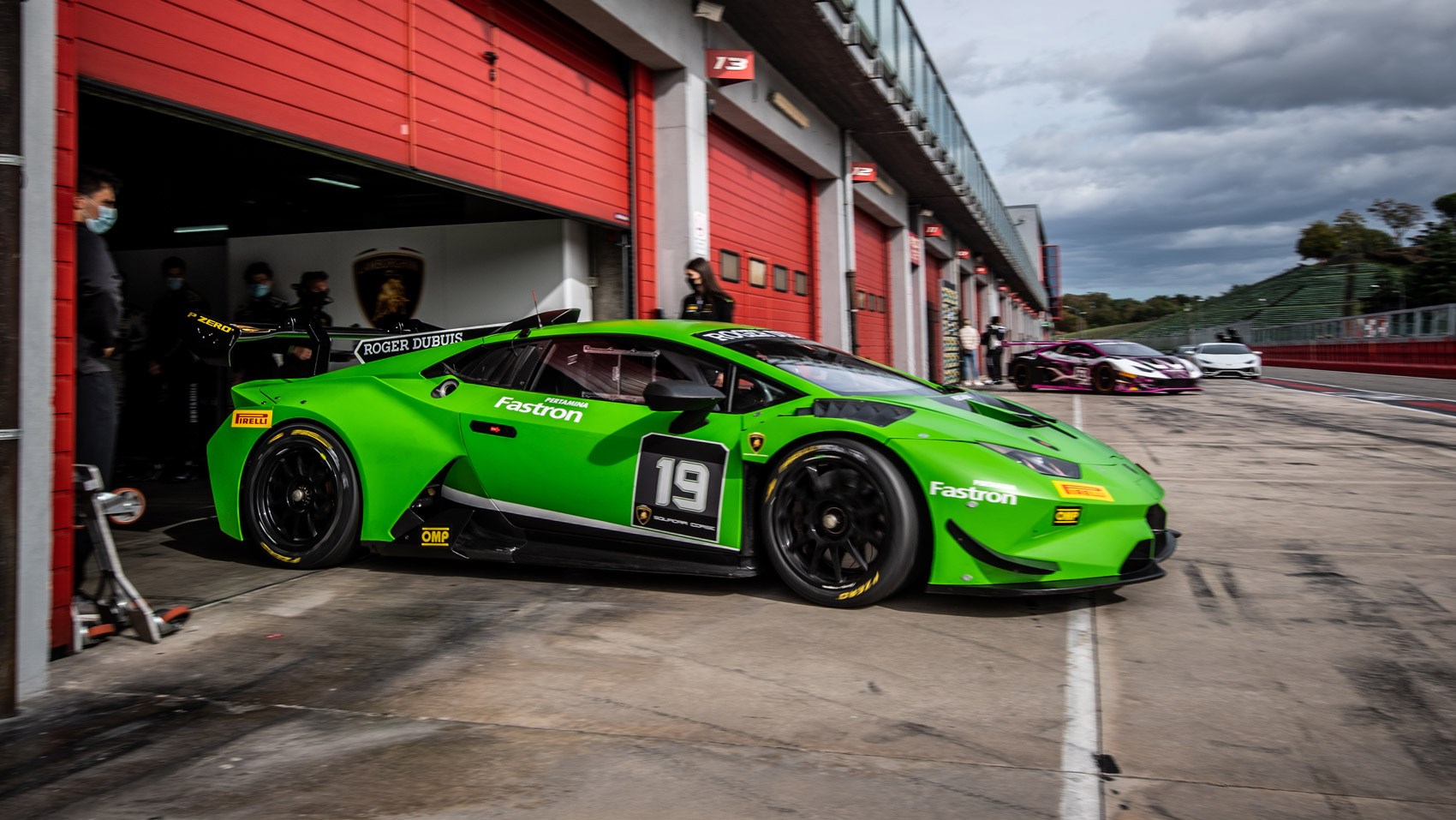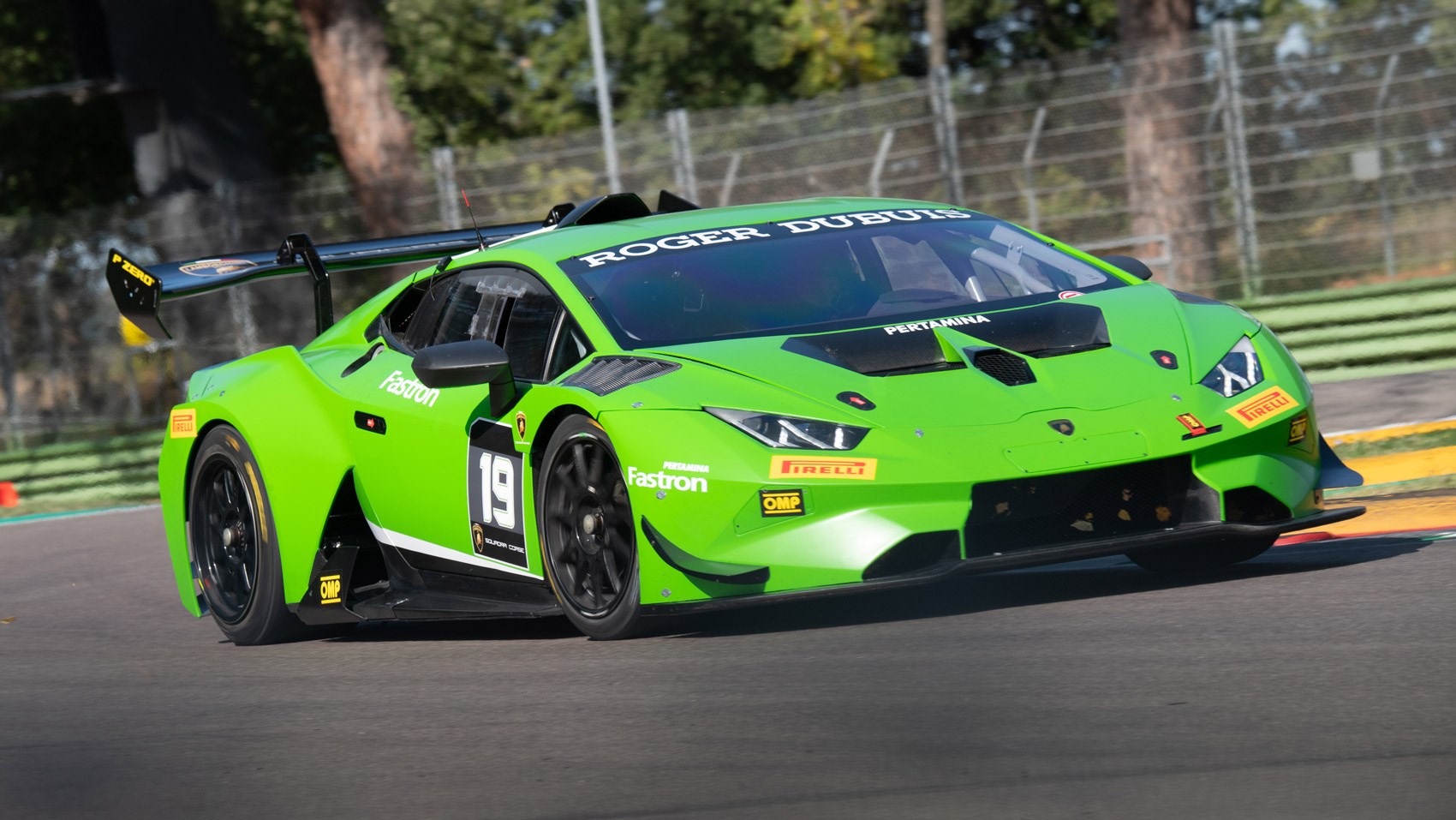► Lambo’s Super Trofeo racer driven
► Slick tyres, full aero package and 611bhp
► Find out why it’s the ultimate raging Bull
For many owners, a standard Lamborghini Huracan simply isn’t enough. It must have more power, more aero, a matte orange wrap and of course, a louder exhaust. Surely, if you’re going to buy a Lamborghini then you may as well go all in and make it the ultimate, right?
Well, for me, you’re wasting your time because this – the Huracan Super Trofeo Evo – is the finest Lambo on sale today. The sole entrant in the one-make Super Trofeo racing series that takes place around the world every year, it features the finest young talent in Europe alongside well-heeled gentleman racers looking for their weekend thrills.
Driving one, then, usually requires superhuman levels of talent or pockets so deep they’re spilling out the bottom of your trousers. I have neither, but despite that, the Lamborghini Squadra Corse (Lamborghini’s racing team to you and me), let me have a go in one. Around Imola. Keep reading to find out just why it’s the ultimate Lamborghini.
How does it differ from a regular Huracan?
Well, here’s a thing. It’s actually got less power than the roadgoing Huracan Evo – 631bhp vs 611bhp. Not the end of the world – especially as it weighs over 200kg less at 1,200kg – but not quite what you’d expect from the ultimate Lamborghini. Crucially, though, the power deficit isn’t down to an engine swap. It’s still got the 5,204cc naturally aspirated V10 showstopper planted just forward of the rear wheels, delivering a 0-62mph time of ‘around 3.0 seconds’ according to one of the pro drivers. I dare say nobody is that bothered.

Other differences include the six-speed Xtrac paddle-shift gearbox, rear-wheel drive layout, Öhlins dampers, a lot of carbon aero additions and a set of big fat sticky Pirelli slicks. There are no Anima drive modes, either. The closest you get is 12-position racing ABS and 9-position traction. And, confusingly, both work in opposite directions meaning you’ll get a nasty shock if you dial each one to their highest numbers expecting the maximum safety net.
What’s it like to drive?
Starting it up requires instructions. As you can see in the pics, the cabin has the odd glimpse of roadgoing Huracan in it yet, for the most part, it’s a full-on spaceship. The steering wheel isn’t, well, a wheel, and the centre console doesn’t have anything like the usual fripperies. Plus, there’s no key to turn or starter button, so cranking it up is a process that requires instruction.
Master switch on, ECU on, ignition on and start. The V10 stirs into life. It’s surprisingly muted, gruff even. No poser-spec rev flare and a total lack of sound insulation work to expose every last element of the engine. To engage 1st gear, you hold the white neutral button on the steering wheel, dip the clutch and pull the right-hand paddle.
Shudder… it’s in – with all the grace of a rhinos in stilettos it must be said. Feathering the clutch and throttle to pull away, this is the last time I’ll use the former until I come back into the pits. The Xtrac gearbox allows you to bang through the ratios without so much as a lift or blip of the throttle – just like the dual-clutch unit in a roadgoing Huracan, but with far more violent changes.
First impressions are that it’s still most definitely a Huracan. A funny statement you might think, but many tin top racing cars share so little with the road going model on which they’re based, they may as well be something completely different. And yet the Super Trofeo Evo still has that Lamborghini feel to it – 90% of which is no doubt down to the engine. Outright speed doesn’t appear that different to the roadgoing car (later runs proved the racer was a little quicker), plus the steeply raked windscreen and mid-engined feel remains.
Thanks to the reduced kerb weight and sticky slick tyres, braking is predictably monstrous – not just in the way they scrub off speed but also how hard you need to hit the pedal. I’m told around 40-50kg of pressure is required to really get the full braking performance, and it’s only when my kneecap is on the brink of exploding does the ABS (set quite generously) start to kick in.
Interestingly, Frederick Schandorff (current GT World Challenge driver and ex Super Trofeo champion) tells me that the friendliness and adjustability of the Super Trofeo car’s brakes are one of the key differences that sets it apart from its GT3 counterpart. And, try as I might, I failed to really get the car unsettled under braking with its level 4 ABS setting activated.
The whole car in fact, is a responsive and forgiving thing to send into one of Imola’s 17 corners. Sure, the top pro drivers will no doubt have a far spikier setup, but the point is that I could simply hop into the Super Trofeo Evo on slick tyres and drive it around Imola will little concern for it spitting me off into one of the many gravel traps. On reflection, it’s the most forgiving and adjustable slick-shod car I’ve ever driven once you start to lean on it.

For my time out on track, we had a road Huracan Evo driven by Jonathon Cecotto (current Super Trofeo driver) leading the way and the differences between road and race car were stark. I’ve already spoke about the differences down the straights, but the braking, mid-corner and exit speed were where the Super Trofeo Evo pulled out the biggest gap.
Where the racing car was flat, composed and arrow sharp in its lines through the corners, poor Jonny was driving the life out of the road going Huracan up front yet still struggling to deal with the inferior braking and stability. More than once did the rear end step out and have to be wrestled under control while the Super Trofeo Evo calmly scythed through each corner. Sure, it held me up at times, but the illustration of (very good) road car vs racing car was a stark reminder of how much performance is left on the table when setting up a chassis for everyday driving.
Lamborghini Huracan Super Trofeo Evo: verdict
Looking at the Huracan Super Trofeo Evo from the outside, you’d expect a snappy, snarling unforgiving rear-wheel drive weapon whose slick tyres will gladly take your head off at the earliest opportunity. And yet, the reality couldn’t be further from the truth.
It’s relation to the road car on which its based is overwhelming (more so than most racing cars) and its ability to cater for the professional drivers and weekend racers alike deeply impressive. If you’re looking for the ultimate Lamborghini thrill, then this is it.
Check out more Lamborghini reviews here